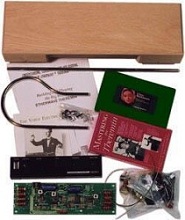
So you got a new theremin for the holidays - Congratulations!
Now that you've opened and assembled it, what's next? Here are some important tips to help you go from "imitator of deranged cat" to "proficient thereminst".
1. Get used to lots of practice
It's no secret that learning to play the theremin takes lots of practice. After all, this is one of the most difficult instruments in the world to play well. Studies have shown that reaching a level of expertice can take at least 10,000 hours of practice. So get started, and keep it up! Pick a pace that works for you but isn't too much that you'll get worn out - maybe 30 minutes to one hour per day. Pay attention to your physical state while practicing too, as it's easy to overdo things early and end up with a sore elbow while you're still getting used to playing.
2. Set up in a suitable space
Your theremin needs to be in a space with at least 5 feet of clearance in all directions. This is necessary so objects around the theremin do not interfere with the pitch or volume antennas. This will help give you the best octave range for your pitch antenna, which will ultimately make it easier for you to learn to play.
3. Ear training
One of the big secrets to playing the theremin well is having the ability to recognize specific pitches, or at least intervals between pitches. If you haven't played other instruments before, this is something you might need extra practice with. You can find pitch training / ear training software online, or you can practice with someone else playing a guitar or piano and try to match the notes and intervals they play. Building up good "pitch memory" over time will help take your theremin playing to the next level.
4. It's all in the approach
Approach your theremin with your volume hand extended towards the loop antenna. This will make the theremin stay quiet as you come close to it. Then bring your pitch hand up to your shoulder. Gradually bring your volume hand up to raise the volume. You should hear a very low bass note at this point, or perhaps silence. If your theremin has a pitch adjustment knob, adjust your theremin such that it hits "zero beat" - or essentially makes no sound while your pitch hand is close to your shoulder. This sets the "base" of your playing range.
5. One hand at a time
Rather than trying to learn to play with both hands at the same time, try with just one hand at a time at first. Once your hands understand the basic concepts, that closer to the pitch antenna increases pitch, and closer to the volume antenna softens the volume, you'll be ready to try them together. When you try them together at first, try holding the pitch steady as you raise and lower the volume. Then alternate and try holding the volume steady as you change pitch. Learning to use both hands independently is the first step in learning how to use them together.
6. Steady... steady...
Another key to success in theremin-playing is being able to hold a note steady without wavering for a length of time. You can practice this simply by picking a note and seeing how long you can hold it without changing pitch. When you think you have it down, jump to another note and try again. Do this at varying positions with your pitch hand close to your shoulder and close to the antenna, as you'll need to be able to hold notes steady throughout the full pitch range.
7. Find a thereminist whose music you enjoy
If I didn't mention this one, you'd surely hear about it in the comments. Never copy the playing style of a thereminist whose music you don't enjoy. There are probably infinite ways to play the theremin, and each subtle variation in style has advantages and disadvantages. Start by spending some time watching thereminists on YouTube or other video services until you find someone whose music you like.
8. Film yourself (But don't share... yet!)
Speaking of YouTube... please resist the urge to film yourself on your first, or second, or tenth day of theremin playing. Trust me on this one. YouTube is filled with hours of people making "I stepped on a cat" sounds on their theremins on day one. We've seen plenty of that. We get the idea. We're really excited you have a theremin, but we'll be much more excited when you record a video of yourself playing a song proficiently. Ok?
9. The Swan is our Stairway to Heaven
Clara Rockmore's rendition of The Swan on theremin is one of the most beautiful and enchanting performances you'll ever hear on the instrument. That doesn't mean it should be the first song you learn. It's so beautiful, many new thereminists tackle it early, get frustrated, and quickly turn their theremins into expensive laundry-drying racks. Instead of starting with something incredibly advanced like this piece, we suggest you find something a little easier while you're still learning the basics.
Besides... everyone learns The Swan... much like everyone learns Stairway to Heaven on electric guitar. You don't want to sound like everyone else, do you? Our community needs more people finding more songs to perform on the theremin... not everyone playing the same song badly.
10. Thereoke!
Believe it or not, karaoke CDs can add a lot of value to your practice time. They can also be a great accompaniment when you're performing live. Try to find some albums with slow/flowing vocals to start with (perhaps some love ballads?). You can find tons of these on Amazon.com and other online retailers. We also recommend the Music Minus One series for cello music, available at SheetMusicPlus.com
.









